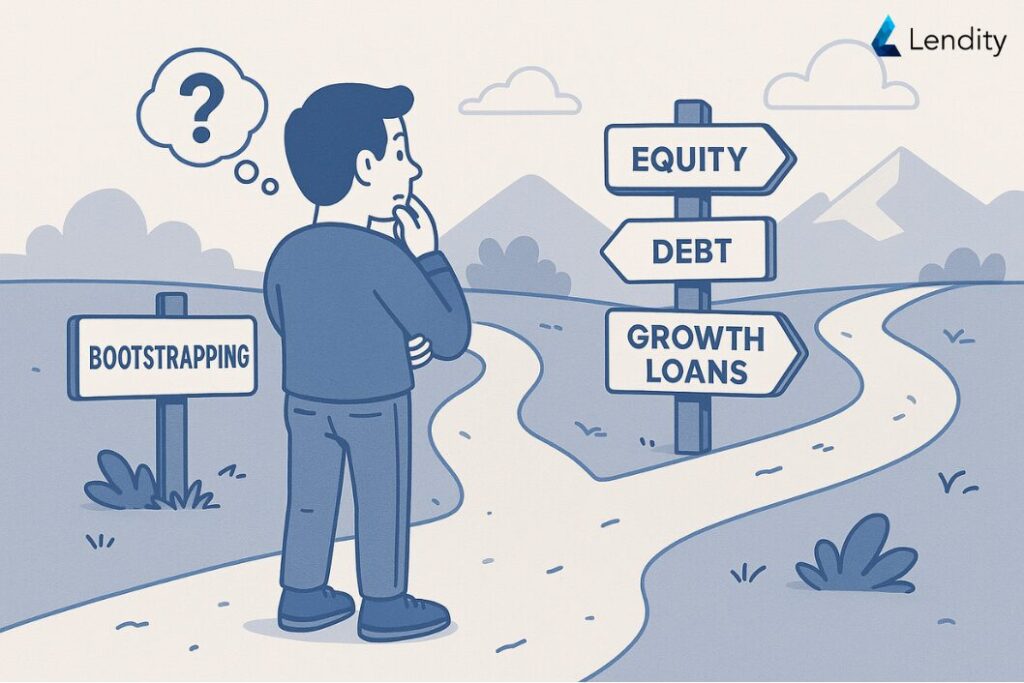Growing Without External Capital: Startup Bootstrapping 101
Pilar Ratti
April 16, 2025
Are bootstrapped companies a miracle within the tech environment? Are all those golden examples we know about just lucky coincidences, or were they carefully premeditated and strategic decisions? Well, if you’d ask me, this is one of the most common misconceptions surrounding bootstrapped startups, and more often than not, the choice of not going for any VC round is anything but random.
Of course, not all industries or products can even consider bootstrapping as an option. But in cases where it is viable, it becomes a strategic choice, one that comes with both advantages and trade-offs. Some companies remain bootstrapped all the way through to an exit, while others do so for years before eventually turning to venture capital or debt to fuel their next stage of growth.
Why would anyone turn down VC money?
You might be wondering: who wouldn’t want to take money to scale a company rapidly? It might seem like a no-brainer at first glance; after all, imagine what you could do with that kind of capital. But opting for a more sustainable and conservative growth path can be just as powerful as going for a VC round or debt eventually. The real question lies in which “tool” you, as a founder, decide to pick out of the entire funding toolkit.
What does bootstrapping actually mean?

Let’s start with the basics: what are bootstrapped companies, anyway?
If we look at its literal definition, the term "bootstrapped" comes from the phrase "to pull oneself up by one's bootstraps," which originally meant attempting the impossible like lifting yourself off the ground by tugging on the straps of your boots.
In the context of startups or business, "bootstrapped" refers to building a company with little or no external funding, relying instead on personal savings, revenue, and reinvestment. These are companies that have grown and evolved without any external funding, no VCs, no angel investors, no debt. They keep the lights on, grow, and scale by reinvesting their own revenue.
Some of the most well-known examples include Mailchimp, which was fully bootstrapped for over 20 years until its exit when it was acquired by Intuit for $12 billion in 2021, and Outseta, which has grown steadily since it was founded in 2016.
In other cases, many companies chose to bootstrap for years until they achieved a solid product-market fit and a sustainable business model, at which point their next growth phase required additional capital. Atlassian was founded in 2002 but didn’t raise its first VC round until 2010, Shopify raised VC funding in 2006 after being fully bootstrapped for six years, securing over $7 million in its first round.
Another way of bootstrapping includes the ‘solo business’ niche. Advocates of bootstrapping and creating profitable companies on their own. There are founders out there, like Danny Postma and Pieter Levels, who are thought leaders within this model, and there’s a whole community of founders and entrepreneurs who embrace this approach, often calling themselves "indie hackers.” They share their stories, offer support, and celebrate this alternative path to building a business.
As you can see, the examples are numerous, and the differences are vast. Choosing to remain bootstrapped can look very different depending on the industry, product, timing, and niche, but what all of them have in common is the goal of opting for steady growth while maintaining control of the business and leveraging capital efficiently (when needed).
The advantages of not leveraging external capital
Now, let’s dig deeper: what makes someone pick bootstrapping over a traditional fundraising route? If you’d ask me, the short answer is maintaining control and avoiding dilution. But the longer answer—one that’s more nuanced and interesting—is that bootstrapping instills a certain mindset and culture that can be incredibly valuable.
- Thoughtful, Steady Growth:
Instead of burning through capital to scale and hoping your product sticks, you’re testing, learning, and refining as you go. Sure, it might be slower, but it builds a solid foundation. By the time you’re ready for bigger steps, you’ll have product-market fit, a strong business model, a clear brand identity, and a culture that truly understands the company’s DNA. - Long-Term Sustainability:
Raising funds can certainly give you a competitive edge in speed, and there’s nothing inherently wrong with that. Some markets demand it. But if you’re building something where a deep understanding of a niche or delivering a unique, quality solution is key, bootstrapping can be absolutely viable. Without external pressure, you can think bigger, aim for sustainability, and develop features that won’t necessarily yield immediate returns but strengthen your product in the long run. - Strong Company Culture: Since every dollar counts, you tend to hire more carefully and thoughtfully, ensuring each new team member is aligned with your mission. This often leads to a tight-knit culture where efficiency, creativity, and customer empathy are second nature.
Funding Tools: Equity, debt and beyond

Equity, whether raised through traditional VC rounds or via other investors, is just one resource in a founder’s toolkit. Debt is another lever, often overlooked, that can help finance certain initiatives without giving up ownership. The key is not dismissing these avenues outright but rather understanding when and why to use them because choosing the wrong funding approach can have long-term consequences on a company’s growth, autonomy, and financial health.
In our most recent article series on the cost of capital, we discussed the cost of equity and the cost of debt. While equity can provide significant runway and access to networks, it also comes at the price of dilution and shifting priorities toward investor expectations. Debt, on the other hand, requires disciplined cash flow management but allows founders to retain control. It is a strong option for companies with predictable revenue streams or those looking to scale without giving up long-term ownership.
Understanding these trade-offs is essential, as the funding method you choose will influence everything from decision-making authority to exit opportunities. The trick is to be more hands-on when choosing your funding strategy rather than leaving it to chance or simply following what everyone else is doing. As a founder, you have the responsibility to pick the right tool for the right use at the right time. Just like you’d choose the right platform, the right team member, or the right market to enter, you should approach funding decisions with the same level of strategic thinking.
This approach doesn’t mean looking down on VCs or dismissing debt as a non-viable route. Quite the opposite: it means acknowledging that these are valuable resources that, when used correctly, can significantly boost your growth under the right circumstances. Instead of adopting a one-size-fits-all mentality, you’re actively crafting a funding roadmap that aligns with your vision, business model, and stage of growth. Ensuring that you make deliberate decisions that genuinely serve your company’s long-term interests rather than reacting to short-term funding pressures.
Weighing the downsizes
Is bootstrapping right for everyone? Certainly not. The lack of immediate capital means you might have to say “no” to some big opportunities until you can afford them from your own profits. You might face slower initial traction and have to be more strategic with your marketing efforts, focusing on word-of-mouth, organic growth, and building a loyal user base rather than going all-in on massive ad campaigns. For many industries, this path is viable, allowing companies to build and scale their products at a sustainable pace.
However, in some cases, bootstrapping simply isn’t an option. Certain businesses, especially those that are capital-intensive, require substantial upfront investment just to get off the ground. Think of companies like Uber, Instagram, or OpenAI—without external funding, their ability to scale and innovate at the speed required by their industries would have been nearly impossible.
But if you thrive on independence, believe wholeheartedly in your vision, and want to retain the steering wheel of your ship without anyone else grabbing at it, bootstrapping could very well be the perfect approach. And if, somewhere along the line, you realize you need a different kind of fuel—be it equity or debt—you’ll have the clarity and confidence to make that choice proactively, not reactively.
Conclusion: a carefully orchestrated strategy
In the end, bootstrapped companies are far from being random miracles. More often than not, they represent a conscious decision to build on one’s own terms. It’s about recognizing that scaling sustainably, maintaining control, and focusing on real customer value can be just as effective as chasing investor-driven hyper-growth. The existence of different funding avenues, from equity to debt, simply adds more tools to your arsenal. Being hands-on with these choices, rather than leaving them to luck, is what sets truly strategic founders apart.

Learn more about Industry Insights
A Healthy B2B SaaS From a Debt Investor Perspective
Tag: Industry Insights

Hardware-as-a-Service: Understanding the Business Model
Tag: Industry Insights

